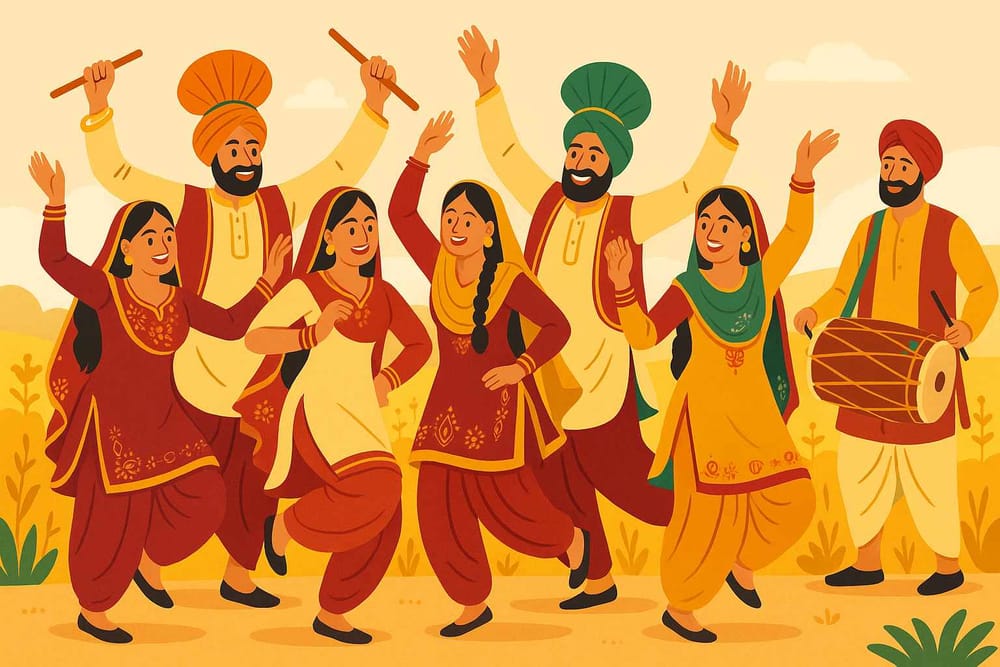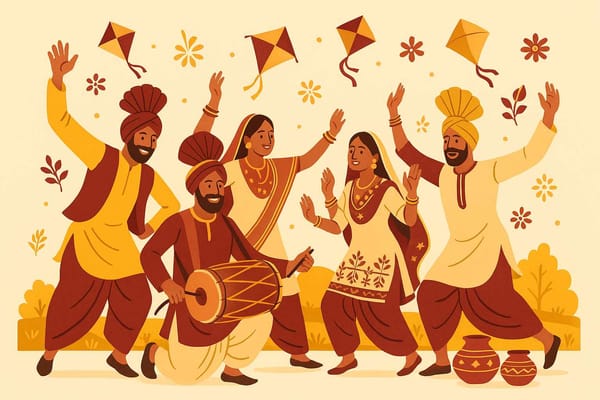
Folk Dances of Punjab- A Vibrant Exploration
Have you ever felt the beat of a dhol reverberate right through your soul? That deep, powerful rhythm that makes you want to drop everything and move? That, my friend, is not just music; it's the very heartbeat of Punjab. It's a land where every festival, every harvest, and every celebration has its own unique rhythm. The folk dances of Punjab are not just performances; they are stories, prayers, and explosions of pure, unadulterated joy that have been passed down through generations.
These dances are a beautiful reflection of the lives of the people – their hard work in the fields, their deep-rooted community bonds, and their zest for life. It's a culture where dance is as natural as breathing, a shared language that everyone understands.
Where It All Began: The Roots of Punjabi Folk Dances
The story of Punjabi folk dances begins in the golden fields, under the vast blue sky. These art forms sprouted from the very soil of the land, born from the simple, everyday life of an agrarian community. They were initially expressions of gratitude for a good harvest, a way to celebrate the changing seasons, and to mark life's precious moments like weddings and births. Think of Bhangra – it wasn't born on a stage, but in the fields during the Vaisakhi festival, as farmers celebrated the fruits of their labour.
These traditions weren't written in books; they were passed down from grandmother to granddaughter, from father to son, through songs and stories shared in village courtyards. This oral tradition has kept them pure and authentic for centuries. In essence, these dances are the living, breathing soul of Punjab’s heritage, a vibrant thread connecting the past to the present. They are a powerful example of how folk music and dance define culture, carrying the spirit of a community forward.
Bhangra – The Pulsating Rhythm of Joy
When you think of Punjabi dance, Bhangra is probably the first thing that comes to mind. And for good reason! Bhangra is the ultimate expression of celebration. It's an explosion of energy, with its vigorous kicks, high leaps, and powerful shoulder movements, all perfectly synchronized to the intoxicating beat of the dhol. Traditionally performed by men to celebrate the harvest, its movements mimic farming activities like sowing and reaping.
The dancers, dressed in colourful kurtas, waistcoats, and vibrant turbans, become a blur of motion and joy. Bhangra has now travelled far from the fields of Punjab, becoming a global phenomenon at weddings and cultural festivals. Yet, at its core, it remains a dance of community, unity, and pure happiness.
Giddha – A Graceful Celebration of Womanhood
If Bhangra is the thunderous roar of Punjab, then Giddha is its graceful, melodious song. Performed by women, Giddha is a beautiful spectacle of feminine grace and expression. It's less about high-octane energy and more about storytelling. The dance is woven around short, poetic verses called boliyan, which are sung by the women themselves. These boliyan can be about anything – from playful banter about in-laws to tales of love and daily life.
With rhythmic clapping and elegant movements, the women create a circle of joy and sisterhood. Dressed in vibrant salwar kameez and adorned with traditional jewellery, they bring stories to life. Giddha is an essential part of weddings and festivals, filling the air with laughter and a deep sense of togetherness.
Beyond the Famous Two: A Tapestry of Rhythms
While Bhangra and Giddha are the most famous, Punjab’s dance heritage is incredibly rich and diverse. Let's explore some other beautiful forms:
- Jhumar: Hailing from the Sandalbar region, Jhumar is a more graceful and rhythmic dance. It is often performed in a circle to a slower beat, with elegant hand movements and swift footwork that create a mesmerising, trance-like effect. It truly feels like the dancers are in a gentle, happy trance.
- Sammi: This is a traditional dance performed exclusively by women, often symbolising resilience and joy. The movements are gentle and intricate, telling stories of longing and love. It’s a dance that speaks volumes through its subtlety and grace.
- Luddi: A dance of victory and celebration, Luddi is performed by men with incredible enthusiasm. It involves energetic, athletic movements, including high jumps and spins, often performed at weddings and festive gatherings to express sheer delight.
- Kikli: A playful and charming dance for young women and girls. Two participants hold hands crosswise and spin around in a circle, singing folk songs. It’s a simple yet beautiful display of friendship and youthful joy that will surely bring a smile to your face.
Dressed in Tradition: The Role of Costumes and Music
You can't talk about Punjabi dances without mentioning the stunning costumes. The vibrant attire is a feast for the eyes and a crucial part of the performance. For women, this means brightly coloured salwar kameez, shimmering dupattas with intricate Phulkari embroidery, and traditional jewellery like jhumkas and tikkas. Men wear colourful turbans, kurtas, and waistcoats that allow for free movement. Much like the beautiful traditional wear you might see in other parts of India, such as the celebratory Rajasthani festival wear, these costumes reflect the cultural vibrancy and pride of the people.
Of course, the soul-stirring music is just as important. The powerful Dhol, the melodic Tumbi, the flute-like Algoza, and the rhythmic Chimta come together to create a sound that is impossible to resist. These instruments provide the energetic beats that guide the dancers' every step.
Answering Your Curiosities about Punjabi Folk Dances
Many people are curious about these vibrant traditions. A common question is how Giddha differs from Bhangra. While both are celebratory, Bhangra is the high-energy, traditionally male dance of the harvest, while Giddha is the graceful, storytelling circle of women, accompanied by their own singing. People also wonder about the main folk dances of Punjab. Beyond Bhangra and Giddha, the landscape is rich with forms like the elegant Jhumar, the joyful Luddi, the traditional Sammi, and the playful Kikli. And yes, these folk dances are very much alive today! They are a proud and central part of weddings, festivals like Vaisakhi, and cultural events not just in Punjab, but across the globe. Anyone with a passion for culture can learn these dances, as many cultural centres offer classes. These art forms are a vital part of Punjabi heritage because they connect people to their roots and beautifully express the community's collective joy and gratitude.
At Bhaktilipi, we believe in preserving and sharing such beautiful cultural treasures. Exploring these traditions helps us connect more deeply with our roots and understand the stories that make us who we are.
Celebrating the Soul of Punjab
The folk dances of Punjab are far more than just entertainment; they are the lifeblood of its culture, a celebration of the unbreakable spirit of its people. Every step, every beat, and every twirl carries the stories, struggles, and joys of generations. Whether it’s the powerful rhythm of Bhangra or the graceful storytelling of Giddha, these dances forge a connection that time cannot break.
By embracing and sharing these vibrant art forms, we honour the legacy of our ancestors and share the incredible beauty of Punjabi culture with the world. Let's celebrate these dances, not just as onlookers but as proud keepers of our rich heritage. After all, it is in these timeless traditions that the true soul of Punjab dances forever.
About Us
Bhaktilipi is your space to explore and preserve timeless bhakti literature from across regions and languages. We bring authentic devotional stories, texts, and rituals to inspire and connect with today’s readers. Learn More
Discover Knowledge with Bhaktilipi
Explore topics like The Vibrant Folk Dances of Punjab and deepen your understanding of India's rich spiritual and cultural heritage. Stay informed, inspired, and connected to tradition through our platform.
Subscribe to our newsletter for updates on new articles and resources. Follow us on Facebook, Instagram, and YouTube for daily inspiration.
A passionate group of people dedicated to preserving India's knowledge of Dharma, Karma, and Bhakti for ourselves and the world 🙏.
Related in

Folk Dances of Punjab-Explore Vibrant Traditions
Close your eyes for a moment. Can you hear it? The powerful, infectious beat of a dhol that seems to echo right from the soul of the earth. Can you see the flash of vibrant colours – the brilliant yellows of mustard fields and the deep indigos of a rural evening
